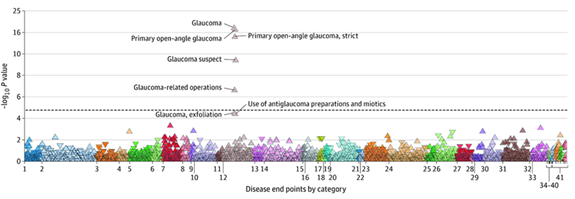Glaucoma is the leading cause of irreversible blindness in the world. It is a progressive disease that damages the optic nerve and retinal nerve fibers, initially leading to visual field defects. In Finland, the myocilin gene variant that is a risk factor for glaucoma is more common than in other countries.
Over 100,000 Finns use glaucoma medication, and the number is expected to significantly increase as our population ages. Glaucoma typically begins after the age of 40 and is influenced by various genetic and environmental factors.
– Glaucoma diagnosed at a younger age may more often be inherited due to errors in a single gene, says doctoral researcher and medical licentiate Perttu Liuska.
– Intraocular pressure remains the only therapeutic target in glaucoma management, and a better molecular understanding of the disease is warranted for future drug development.
Pathogenic variants in myocilin (MYOC), the most prevalent monogenic glaucoma gene, have been identified in 2 to 4% of individuals with adult-onset and in up to 6–36% of individuals with open-angle glaucoma (typically classified as glaucoma diagnosed before the age of 40 years). Misfolded myocilin protein appears to accumulate in cells and block the outflow of aqueous humor from the eye. When the circulation of aqueous humor is disrupted, the pressure in the eye increases, leading to damage to the delicate optic nerve.

Perttu Luiska. Photo: Jasper Löfgren
Liuska found in his thesis that myocilin gene variants were the most common causes of juvenile glaucoma in Finland as well. Fifty families with juvenile glaucoma were collected from the HUS Department of Ophthalmology. A genetic variant causing glaucoma was found in 14% (7/50), and myocilin gene variants explained 10% of glaucoma cases (5/50).
– We identified new genetic defects in several families causing glaucoma. This information provides an opportunity to screen for genetic variants in other family members and identify glaucoma early before it causes permanent vision damage, says Liuska.
Genetic risk factors for glaucoma other than the myocilin gene have also been identified. On the other hand, potential hereditary protective factors, such as certain variants of apolipoprotein E (APOE), have also been identified recently. Association of APOE variants with eye diseases have been confirmed in international research projects.
The thesis utilized the unique FinnGen study data, that combines the genetic and digital health record data of hundreds of thousands of Finnish individuals. This revealed that the common glaucoma predisposing myocilin gene variant p. (Gln368Ter) is more prevalent in Finland than in the rest of the world. Up to 0.33%, or almost 20,000 Finns, carry this variant. In Finland, this variant appears to be a strong predisposing factor for the development of high-pressure glaucoma. Liuska demonstrated for the first time that the variant is also associated with exfoliation glaucoma, a common abnormality in the anterior segment of the eye, in the Nordic countries.
The hereditary risk factor for Alzheimer's disease, a variant in the apolipoprotein E4 (APOE4), is common in the Nordic countries. Almost a third of Finns have at least one copy of this risk allele. In the Finnish population, the same APOE4 variants paradoxically appear to protect against age-related macular degeneration and glaucoma, although the protective effect against glaucoma appeared relatively modest.
– My thesis investigated the genetic background of glaucoma in both the patient data collected based on juvenile glaucoma and in the FinnGen study data. Understanding the genetic risk factors for glaucoma will allow us to better identify patients at risk in the future and possibly develop new drugs in the future, says Liuska.
Perttu Liuska's doctoral research was conducted in collaboration with the HUS Department of Ophthalmology, the University of Helsinki, and the Eye Genetics Group at Folkhälsan Research Center.
Perttu Liuska will defend his doctoral dissertation entitled "Myocilin and the genetics of open-angle glaucoma in Finland" on Friday 1 December at 12 EEST in the Faculty of Medicine, University of Helsinki. The public examination will take place at the following address: Haartman-instituutti, sali 2, Haartmaninkatu 3, Helsinki.
medical licentiate Perttu Liuska
perttu.liuska@helsinki.fi, +358 50 461 5995

Manhattan plot of the association of the most common glaucoma-causing gene variant in the myosin gene c.1102C>T, p.(Gln368Ter) with different types of glaucoma in the FinnGen study database. On the y-axis, the p-value is presented as a decimal logarithm for convenience. The X-axis shows the numerous different disease groups in FinnGen, of which only the different glaucoma endpoints emerge as clearly significant.
